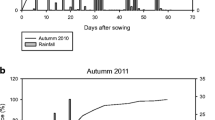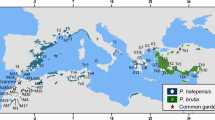Abstract
The population dynamics ofMazus japonicus andM. Miquelii was compared.
In contrast with the summer annual growth habit (Vandellia crustacea) and the winter one(Veronica persica), M. japonicus had a “year-long annual growth habit” as the population of this species existed all year-round, notwithstanding that each individual of the population germinated and died within a year.
TwoMazus species were sympatric on the levee of a rice paddy field where many other species were thickly grown. Those two species were difficult to propagate there, because their seeds, which were light germinators, could hardly germinate in the shade of other plants, or even if germination was possible, their seedlings may have soon died. However, asM. Miquelii, a perennial species, was able to reproduce by stolon vegetatively, it was a dominant species on the levee. On the contrary, the population density ofM. japonicus was thicker in the abandoned paddy field and an upland field than that ofM. Miquelii, because seeds of the former germinated under a greater variety of temperatures and under conditions of less soil moisture than those of the latter.
These observations present an example of the fact that the difference of the reproductive strategy in annual and perennial plants has a striking effect on the population dynamics in the sympatric habitat.
Similar content being viewed by others
References
Antonovics, J. 1968. Evolution in closely adjacent plant populations. V. Evolution of self-fertility. Heredity23: 219–238.
Baker, H.G. 1955. Self-compatibility and establishment after “long-distance” dispersal. Evolution9: 347–348.
— 1959. Reproductive methods as factors in speciation in flowering plants. Cold Spring Harbor Symp. Quant. Biol.24: 177–190.
— 1974. The evolution of weeds. Ann. Rev. Ecol. Syst.5: 1–24.
Harper, J.L. 1967. A Darwinian approach to plant ecology. J. Ecol.55: 247–270.
— 1977. Population Biology of Plants. Academic Press, London.
— andJ. Ogden. 1970. The reproductive strategy of higher plants. 1. The concept of strategy with special reference toSenecio vulgaris L. J. Ecol.58: 681–698.
— andJ. White. 1974. The demography of plants. Ann. Rev. Ecol. Syst.5: 419–463.
Jain, S.K. 1976. The evolution of inbreeding in plants. Ann. Rev. Ecol. Syst.7: 469–495.
Kawano, S. 1974. Evolutionary Biology in Plants II. Speciation and Adaptation. Sanseido, Tokyo (in Japanese).
Kimata, M. 1978. Comparative studies on the reproductive systems ofMazus japonicus andM. Miquelii, Scrophulariaceae. Pl. Syst. Evol.129: 243–253.
Lefébvre, C. 1970. Self-fertility in maritime and zinc mine populations ofArmeria maritima (Mill.) Willd. Evolution24: 571–577.
Penfound, W.T. andJ.A. Howard. 1940. A phytosociological analysis of an evergreen oak forest in the vicinity of New Orleans, La. Amer. Midl. Nat.23: 165–174.
Raynal, D.J. andF.A. Bazzaz. 1975. The controlling life-cycle strategies of three summer annuals found in abandoned field in Illinois. J. Ecol.63: 587–596.
Stebbins, G.L. 1957. Self fertilization and population variability in higher plants. Amer. Nat.91: 337–354.
— 1958. Longevity, habitat, and release of genetic variability in the higher plants. Cold Spring Harbor Symp. Quant. Biol.23: 365–378.
Author information
Authors and Affiliations
Rights and permissions
About this article
Cite this article
Kimata, M., Sakamoto, S. Comparative studies on the population dynamics ofMazus japonicus andM. Miquelii, scrophulariaceae. Bot Mag Tokyo 92, 123–134 (1979). https://doi.org/10.1007/BF02493385
Received:
Issue Date:
DOI: https://doi.org/10.1007/BF02493385




